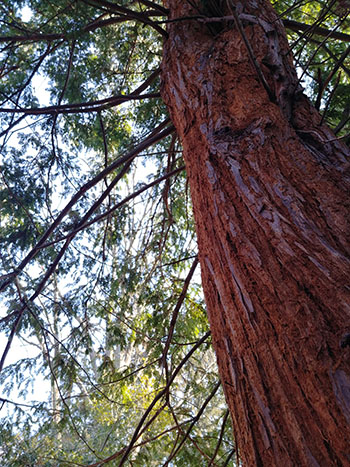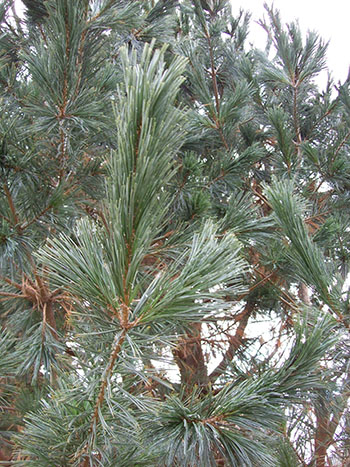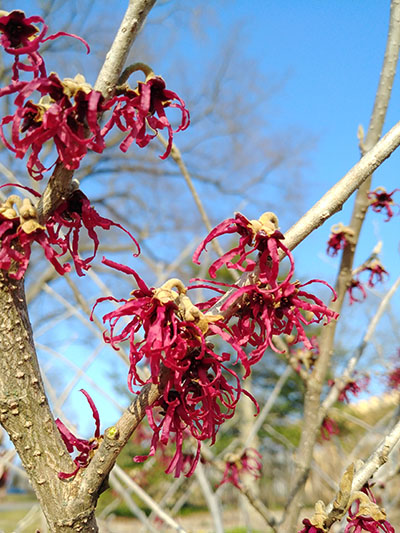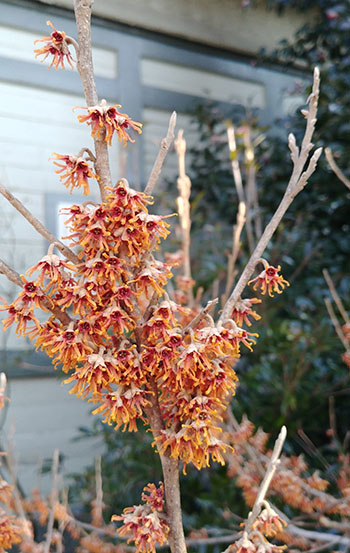
Plants of the Week: March 8
Evergreen plants provide structure and color in the garden throughout the year. Through the long weeks of winter, I look to conifers for inspiration and beauty. Many exceptional selections of conifers are found throughout the Arboretum and within the Pinetum.

One such tree to grace the campus is the coast redwood (Sequoia sempervirens), one of the most majestic trees in the world. photo credit: R. Payne-Meyer
One such tree to grace the campus is the coast redwood (Sequoia sempervirens), one of the most majestic trees in the world. Through the foggy depths of the U.S. Pacific Coast, these trees soar to heights unmatched. S. sempervirens is the tallest species in the world, and one of the longest lived as well; these trees can live to over 2000 years. A rare sight in East Coast gardens, this Pacific giant finds a happy home in the Philadelphia region. S. sempervirens craves plentiful moisture and high humidity, but is intolerant of drought and temperature extremes (recommended only in zones 7-9). With its grand stature and lustrous, ferny needles, this tree has obvious landscape appeal, but I’m also drawn to the fibrous red-orange bark which contrasts the dark foliage.

P. flexilis ‘Vanderwolf’s Pyramid’ is a popular cultivar with long blue-green needles, and an upright growth form, surprisingly dense for a pine. photo credit: J. Coceano
Also having roots on the West Coast is the limber pine (Pinus flexilis) another conifer, but one with much different habits. Growing from Canada to Mexico, this tree grows at high altitudes and is often subjected to extreme conditions. Mountaintop dwellers hang on as contorted dwarfs. The common name “Limber Pine” and specific epithet flexilis, hint at the flexible nature of this Rocky Mountain native, whose limbs withstand heavy winds and weather loads. In an East Coast winter marked by an unpredictable mix of snow, ice, and sleet, this characteristic has its value in our region too, where many pine species are damaged by winter weather.
P. flexilis trees grown in cultivation typically develop a neat pyramidal shape and offer a number of landscape attributes. Older specimens become looser and can resemble Pinus parviflora (Japanese white pine), or Pinus strobus (eastern white pine). P. flexilis ‘Vanderwolf’s Pyramid’ is a popular cultivar with long blue-green needles, and an upright growth form, surprisingly dense for a pine. ‘Vanderwolf’s Pyramid’ is adaptable, drought tolerant and hardy to zone 4. This species does not perform well farther south than our zone 7, but seems content here. This tree can also be very long-lived in its natural setting, with these trees also recorded to live over 2000 years.
Turning the clock from winter to spring are witchhazels, their flowers occurring in a profusion of yellow, orange, red, and pink tones. I like almost all of the witchhazels represented at the Arboretum, but recently two have stood out to me for their unique floral coloration.

Hamamelis japonica ‘Tsukubana-kurenai’ (Japanese witchhazel) flowers display a rare tone: an almost fluorescent red-pink. photo credit: R. Payne-Meyer
Hamamelis japonica ‘Tsukubana-kurenai’ (Japanese witchhazel) flowers display a rare tone: an almost fluorescent red-pink. I have seen my share of red witchhazels, but the pink pigments in these flowers really jump out to my eye. The flowers also offer a light tangerine aroma.

Hamamelis vernalis ‘Quasimodo’ blooms (vernal witchhazel) offer a one of a kind, burnt-auburn hue. photo credit: R. Payne-Meyer
Hamamelis vernalis ‘Quasimodo’ blooms (vernal witchhazel) offer a one of a kind, burnt-auburn hue. I love all orange flowers, but this tone is not one I have seen replicated on other plants. Close observation reveals yellow flushed petals, though the flowers appear rusty at a distance. H. vernalis ‘Quasimodo’ has dense clusters of miniature flowers with a zesty, almost lilac-like aroma. The compact growth form of this variety is very pleasing too, and negates what I feel to be a negative quality of this genus: the rangy, sprawling habit of mature shrubs.





No Comments